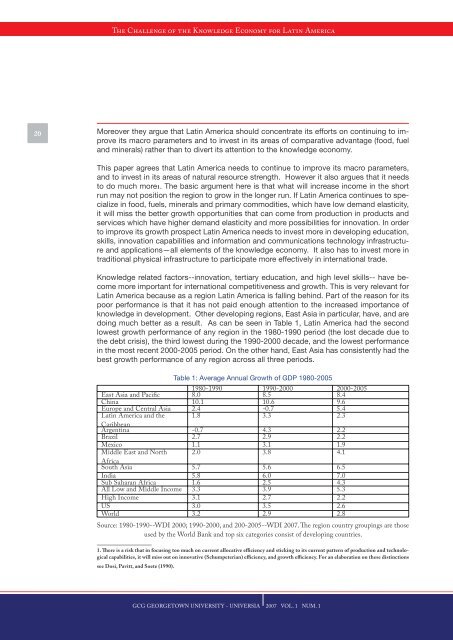2007 Vol. 1 Num. 1 - GCG: Revista de Globalización, Competitividad ...
2007 Vol. 1 Num. 1 - GCG: Revista de Globalización, Competitividad ...
2007 Vol. 1 Num. 1 - GCG: Revista de Globalización, Competitividad ...
Create successful ePaper yourself
Turn your PDF publications into a flip-book with our unique Google optimized e-Paper software.
The Challenge of the Knowledge Economy for Latin America<br />
20<br />
Moreover they argue that Latin America should concentrate its efforts on continuing to improve<br />
its macro parameters and to invest in its areas of comparative advantage (food, fuel<br />
and minerals) rather than to divert its attention to the knowledge economy.<br />
This paper agrees that Latin America needs to continue to improve its macro parameters,<br />
and to invest in its areas of natural resource strength. However it also argues that it needs<br />
to do much more1. The basic argument here is that what will increase income in the short<br />
run may not position the region to grow in the longer run. If Latin America continues to specialize<br />
in food, fuels, minerals and primary commodities, which have low <strong>de</strong>mand elasticity,<br />
it will miss the better growth opportunities that can come from production in products and<br />
services which have higher <strong>de</strong>mand elasticity and more possibilities for innovation. In or<strong>de</strong>r<br />
to improve its growth prospect Latin America needs to invest more in <strong>de</strong>veloping education,<br />
skills, innovation capabilities and information and communications technology infrastructure<br />
and applications—all elements of the knowledge economy. It also has to invest more in<br />
traditional physical infrastructure to participate more effectively in international tra<strong>de</strong>.<br />
Knowledge related factors--innovation, tertiary education, and high level skills-- have become<br />
more important for international competitiveness and growth. This is very relevant for<br />
Latin America because as a region Latin America is falling behind. Part of the reason for its<br />
poor performance is that it has not paid enough attention to the increased importance of<br />
knowledge in <strong>de</strong>velopment. Other <strong>de</strong>veloping regions, East Asia in particular, have, and are<br />
doing much better as a result. As can be seen in Table 1, Latin America had the second<br />
lowest growth performance of any region in the 1980-1990 period (the lost <strong>de</strong>ca<strong>de</strong> due to<br />
the <strong>de</strong>bt crisis), the third lowest during the 1990-2000 <strong>de</strong>ca<strong>de</strong>, and the lowest performance<br />
in the most recent 2000-2005 period. On the other hand, East Asia has consistently had the<br />
best growth performance of any region across all three periods.<br />
Table 1: Average Annual Growth of GDP 1980-2005<br />
East Asia and Pacific<br />
1980-1990<br />
8.0<br />
1990-2000<br />
8.5<br />
2000-2005<br />
8.4<br />
China 10.1 10.6 9.6<br />
Europe and Central Asia 2.4 -0.7 5.4<br />
Latin America and the 1.8 3.3 2.3<br />
Caribbean<br />
Argentina -0.7 4.3 2.2<br />
Brazil 2.7 2.9 2.2<br />
Mexico 1.1 3.1 1.9<br />
Middle East and North 2.0 3.8 4.1<br />
Africa<br />
South Asia 5.7 5.6 6.5<br />
India 5.8 6.0 7.0<br />
Sub Saharan Africa<br />
All Low and Middle Income<br />
1.6<br />
3.3<br />
2.5<br />
3.9<br />
4.3<br />
5.3<br />
High Income 3.1 2.7 2.2<br />
US 3.0 3.5 2.6<br />
World 3.2 2.9 2.8<br />
Source: 1980-1990--WDI 2000; 1990-2000, and 200-2005--WDI <strong>2007</strong>. The region country groupings are those<br />
used by the World Bank and top six categories consist of <strong>de</strong>veloping countries.<br />
1. There is a risk that in focusing too much on current allocative efficiency and sticking to its current pattern of production and technological<br />
capabilities, it will miss out on innovative (Schumpeterian) efficiency, and growth efficiency. For an elaboration on these distinctions<br />
see Dosi, Pavitt, and Soete (1990).<br />
<strong>GCG</strong> GEORGETOWN UNIVERSITY - UNIVERSIA <strong>2007</strong> VOL. 1 NUM. 1















